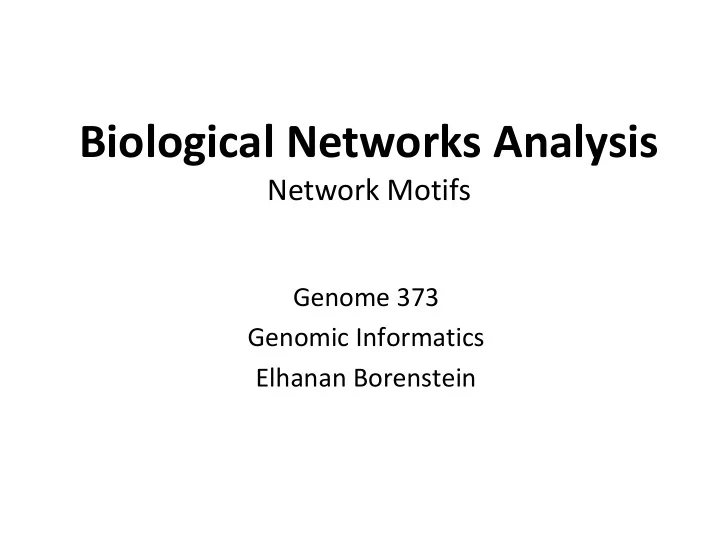

Biological Networks Analysis Network Motifs Genome 373 Genomic Informatics Elhanan Borenstein
A quick review Networks: Networks vs. graphs A collection of nodes and links Directed/undirected; weighted/non- weighted, … Networks as models vs. networks as tools Many types of biological networks The shortest path problem Dijkstra’s algorithm 1. Initialize : Assign a distance value, D, to each node. Set D=0 for start node and to infinity for all others. 2. For each unvisited neighbor of the current node: Calculate tentative distance, D t , through current node and if D t < D: D D t . Mark node as visited. 3. Continue with the unvisited node with the smallest distance
A quick review Degree = Number of neighbors Degree distribution Power-law degree distribution: Scale free networks Allows hubs in the network Affects error and attack tolerance Most (all) real-life networks seem to have a power-law degree distribution
Why do so many real-life networks exhibit a power-law degree distribution? Is it “selected for”? Is it expected by chance? Does it have anything to do with the way networks evolve? Does it have functional implications? ?
Network motifs Going beyond degree distribution … Basic building blocks Evolutionary design principles? Generalization of sequence motifs
What are network motifs? Recurring patterns of interaction ( sub-graphs ) that are significantly overrepresented (w.r.t. a background model) 13 possible 3-nodes sub-graphs (199 possible 4-node sub-graphs) R. Milo et al. Network motifs: simple building blocks of complex networks. Science, 2002
Finding motifs in the network 1a. Scan all n-node sub-graphs in the real network 1b. Record number of appearances of each sub-graph ( consider isomorphic architectures ) 2. Generate a large set of random networks 3a. Scan for all n-node sub-graphs in random networks 3b. Record number of appearances of each sub-graph 4. Compare each sub- graph’s data and identify motifs
Finding motifs in the network
Network randomization How should the set of random networks be generated? Do we really want “completely random” networks? What constitutes a good null model?
Network randomization How should the set of random networks be generated? Do we really want “completely random” networks? What constitutes a good null model? Preserve in- and out-degree
Generation of randomized networks Network randomization algorithm : Start with the real network and repeatedly swap randomly chosen pairs of connections (X1 Y1, X2 Y2 is replaced by X1 Y2, X2 Y1) X1 Y1 X1 Y1 X2 Y2 X2 Y2 (Switching is prohibited if the either of the X1 Y2 or X2 Y1 already exist) Repeat until the network is “well randomized”
Motifs in transcriptional regulatory networks E. Coli network 116 TFs 577 interactions Significant enrichment of motif # 5 Master TF X Specific TF Y Target Z (40 instances vs. 7±3) Feed-Forward Loop (FFL) S. Shen-Orr et al. Nature Genetics 2002
What’s so interesting about FFLs Boolean Kinetics dY / dt F ( X , T ) aY y dZ / dt F ( X , T ) F ( Y , T ) aZ y z A simple cascade has slower shutdown A coherent feed-forward loop can act as a circuit that rejects transient activation signals from the general transcription factor and responds only to persistent signals, while allowing for a rapid system shutdown.
Network motifs in biological networks
Network motifs in biological networks
Network motifs in biological networks
Network motifs in biological networks
Network motifs in biological networks
Network motifs in biological networks Why do these networks have similar motifs? Why is this FFL motif is network so under-represented! different?
Information Flow vs. Energy Flow FFL motif is under-represented!
Network Motifs in Technological Networks
Motif-based network super-families R. Milo et al. Superfamilies of evolved and designed networks. Science, 2004
Recommend
More recommend